Are you going to be siding your house but find that the gas pipe is too close to the wall? Natural gas is a dangerous substance, it is not for nothing that all work associated with it is strictly regulated. Agree, neither problems with the gas service, nor the threat of an explosion after finishing you do not need.
Every year, dozens of people die from explosions and fires in household gas, and hundreds more are deprived of their homes. In most cases, the cause of the tragedy is precisely the incorrectly performed re-equipment. If everything is done according to the instructions, a fresh facade will not only be beautiful, but also safe.
The representatives of the gas service do not care about the beauty of the facade of your house, their demands are justified only by safety. We will tell you about the compromise options, how to close the gas pipe with siding, in which the result will meet all standards and look aesthetically pleasing. At the same time, we will figure out what standards exist and what requirements of gas workers are legitimate.
The content of the article:
- When will the pipe interfere with the siding?
- Legal requirements for the gas pipeline
-
Solutions to the problem
- Option # 1 - move the pipe on the brackets
- Option number 2 - transfer of the pipe by gas workers
- Option number 3 - open channel in siding
- Sewing up a pipe - what is the threat?
- Conclusions and useful video on the topic
When will the pipe interfere with the siding?
Before you figure out how to solve a problem, it is worth finding out if it applies specifically to your situation. A gas pipeline can only cause siding problems when it runs along the wall of a building.
In addition, if you are sheathing a house without insulation, with a crate with a minimum height or without it at all, you the existing gap between the wall and the pipe may be quite enough, and nothing to do with it would need.
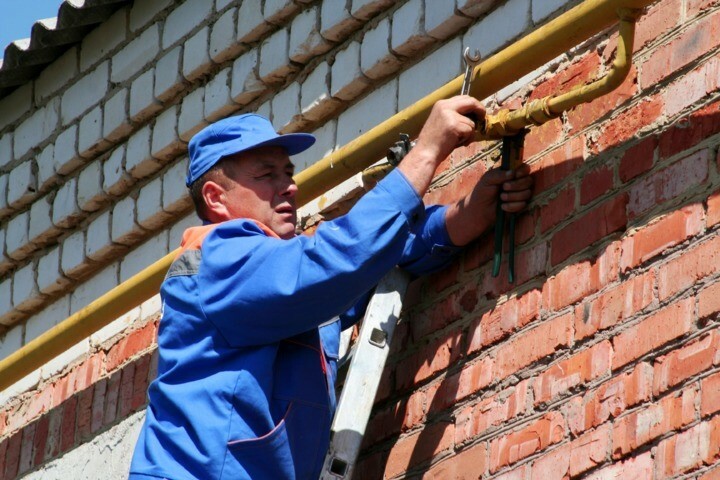
All work related to the gas pipeline must be performed by a certified specialist of the relevant service - it is safer, do not take responsibility
The pipe will become a hindrance if it is already located at a distance of no more than 6 - 7 cm from the wall, as well as if at the moment there are already violations in its location. Another reason for replacing a pipe, and at the same time its displacement, may be its deterioration - for example, rusty spots that threaten a gas leak.
Legal requirements for the gas pipeline
There are a number of regulations that gas workers can refer to in this matter. Among them: building codes and regulations 42-101-2003, 2.04.08-87, 31-02, 2.07.01-89, and, Safety rules in the gas industry, Rules for the design and safe operation of pressure vessels, Rules for the use of gas in the national economy other.
According to these documents, gas pipelines are external and internal, those that are located inside buildings. The former are divided into above-ground (on supports or walls), above-ground (in embankments) and underground. In addition, gas pipelines differ in pressure, depending on the purpose and diameter.
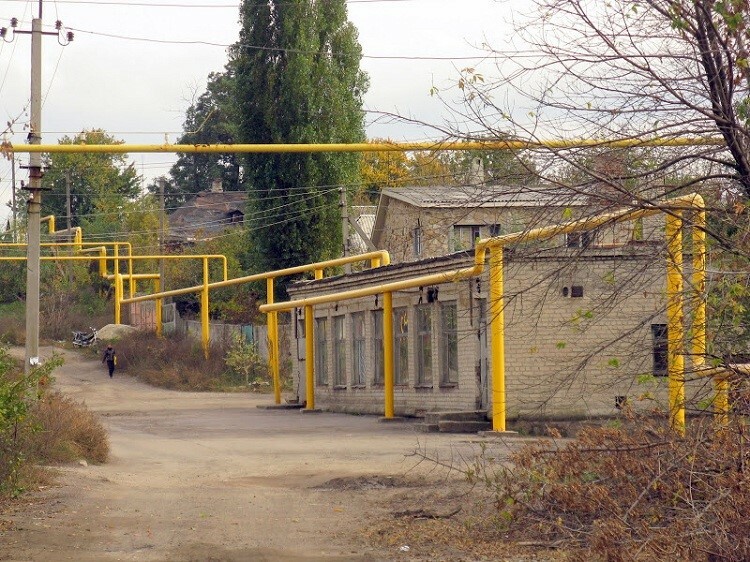
Private consumers are connected with pipes with low pressure, up to 0.05 kgf / cm2, but the main pipe, from which pipes are diverted to each house, already refers, as a rule, to pipelines with medium pressure, up to 3 kgf / cm2
All work on all types of gas equipment, from laying the mains to connecting the stove in the house, must be carried out by qualified specialists, certified and authorized to carry out such works.
Only specialists know and will be able to comply with all standards, requirements for all SNiP, as well as the rules of the Ministry of Emergency Situations and electricity supply services.
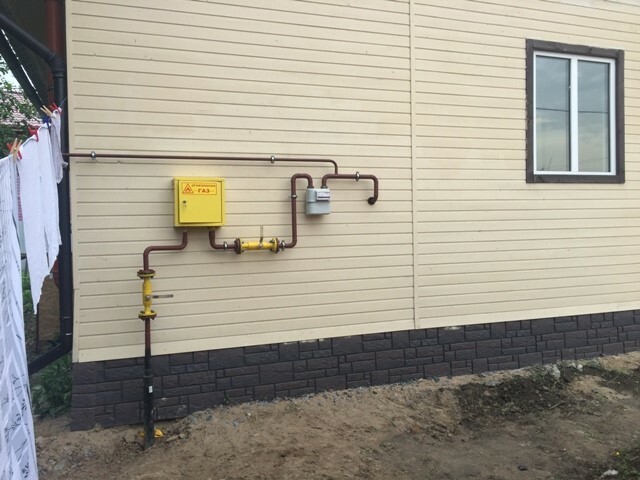
Gas supply to the house underground allows you to get rid of pipes in the yard - it's beautiful, convenient and safe
To find out whether your gas pipe has been correctly laid now, whether the correct location will remain after siding, and where it can be transferred, if necessary, we recommend that you familiarize yourself with the following requirements of the listed regulatory legal acts:
- gas is supplied to residential buildings in an open way - so that at any time there is an opportunity to assess the condition of the pipe, its prevention, maintenance and repair;
- the gas pipe can be fixed on support poles or attached to the wall of the building. Perhaps, in order to solve the problem of finishing and extensions once and for all, it is worth taking it out on supports away from the building. The distance between such supports for each specific case is indicated in SNiP 2.04.12-86;
- the pipe laid along the outer wall must be located at a height of at least 2.2 m from the ground;
- there must be at least 0.2 m from the gas pipeline to the roof;
- it is forbidden to lay pipes closer than 0.5 m from windows and doors, as well as to install detachable connections under windows and balconies;
- a valve that cuts off the gas supply should be located no closer than 50 cm horizontally from windows and doors;
- from the wall surface to the pipe, the gap must be at least 6 cm;
- the pipe is fixed to the wall on hooks-brackets or clamps with a rubber electrically insulating gasket;
- it is forbidden to fix the pipe to fasteners by welding;
- it is forbidden to lay gas pipes along the wall medium and high pressure - it is better to bring them underground, with an exit to the surface immediately before entering the house;
- on a site where there are no pedestrian paths and motorways, the gas pipeline can be located at a height of 35 cm from the ground. However, in practice, it is rarely lowered below 2 m, because the pipe must go high along the wall, and the common distribution pipe is carried on supports about 2 m high.
Pipes need to be painted only with yellow paint that is resistant to temperature extremes and moisture - for example, oil or alkyd enamel. Apply 2 coats of primer under the paint, and the paint itself is also applied in 2 coats.
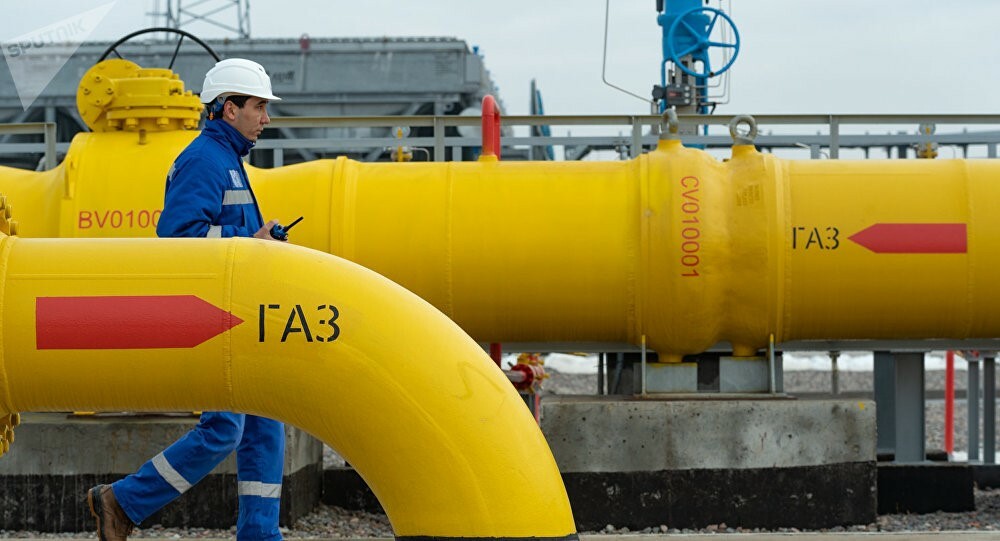
According to the norms, it is also necessary to mark the direction of gas movement with red arrows, in practice, in low-pressure gas pipelines, they do without this.
Thus, according to the regulations, the answer to the question "is it possible to close a gas pipe with siding?" will be negative.
Solutions to the problem
If the gas pipe, fixed on the outside of the house, after finishing will pass at a distance less than 5 cm from the siding surface or even under it, there are several solution options Problems.
It depends on the specific location of the gas pipeline, as well as on how much money, effort and time you are willing to spend the owner on solving this issue. Let's consider the main options, their methods of implementation, advantages and disadvantages.
Option # 1 - move the pipe on the brackets
This is perhaps the easiest way out, but it is not available in every situation. This method assumes that the long pipe has some flexibility, which means that it can simply be moved away from the wall by lengthening the mounting brackets.
The ideal situation for this option is siding of smooth walls, without lathing and insulation. In this case, an offset of only a few centimeters will be required - only by the thickness of the most convex part of the siding.
In the best case, an offset is possible by 5, maximum 10 cm, so if a layer of insulation is planned under the siding, this is unlikely to be enough. In addition, if the pipe is rigidly fixed, for example, on a support, or welded to main pipe close to the corner of a house, this method may not work. Difficulties may also arise in entry point into the house, because violence and strong bending are unacceptable.
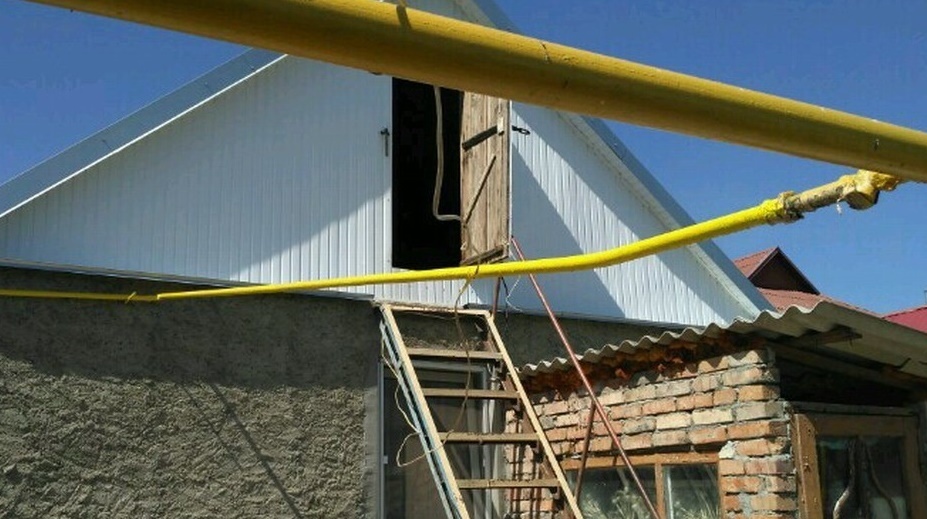
The photo shows an example of a pipe that can be moved away from the wall without the help of gas workers, due to its flexibility, only by lengthening the fasteners
This option is practically free, you only need to buy new long brackets, and they are inexpensive. It is also possible that you will have to pay extra to the planking masters for their installation and fixation of the pipe.
This method also does not require time expenditures: if the pipe can be moved in this way in principle, then this can be done quickly, during the preparation of the surface for sheathing.
Before you start decorating the walls, solve the issue with the pipe. For added safety, turn off the valve at the beginning of the pipe, if there is one. Try to remove it from the brackets - it can be rigidly fixed to them with layers of paint.
Instead of brackets, the pipe can be fixed with hooks on which the pipe lies, or with clamps wrapping around it - in the second case, they should be untwisted. It is better to take new fasteners in the form of clamps so that the pipe does not spring to the wall, in its natural position. Fix the brackets securely to the wall and then the pipe in the clamps.
Option number 2 - transfer of the pipe by gas workers
In terms of safety and reliability, this option is the most preferable. This method is perhaps the most expensive in terms of time, money, and nerves. But the result will be 100% legal and safe, the pipe will not interfere with the finishing, and in the future there will be no problems with safety and its maintenance.
Such a solution to the problem is always possible, the only "contraindication" may be the urgency of the work, because it will not be possible to solve this issue in a day or two. In addition, you will need all the documentation for the house and site, from ownership to gasification plan - naturally, she should be fine too.
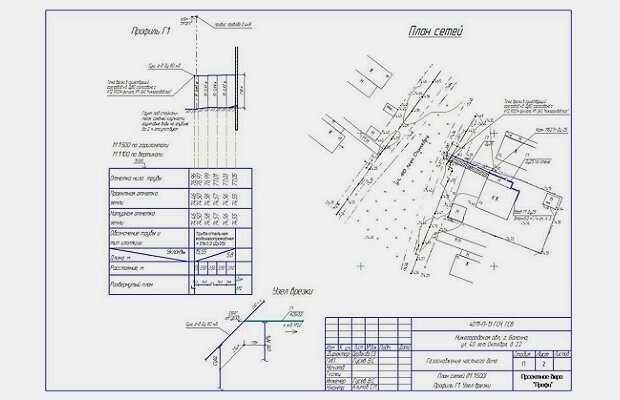
It is better to entrust the drawing up of a gasification plan to a specialized design office, because everything must be noted accurately and on a certain scale.
The advantages of this method are: reliability, legality, safety, it will not interfere with high-quality insulation. Among the disadvantages, it is worth noting the high cost and duration of the process.
The exact amount of costs depends on the region and the company servicing the gas pipeline at the site. In addition to the work of gas workers and materials, you will have to pay for the preparation and execution of a project approved by the gas service. In addition to the official rates of Gorgaz, you can always negotiate directly with their own qualified foreman, and this, for sure, will come out cheaper.
Provided that you have all the necessary documents for the house in order, the paperwork will take from 2 days to a week. After that, the date of the gasman's visit will be agreed with you, which depends on the employment of specialists. A certified specialist from the city gas service may be free the next day or only a month later.
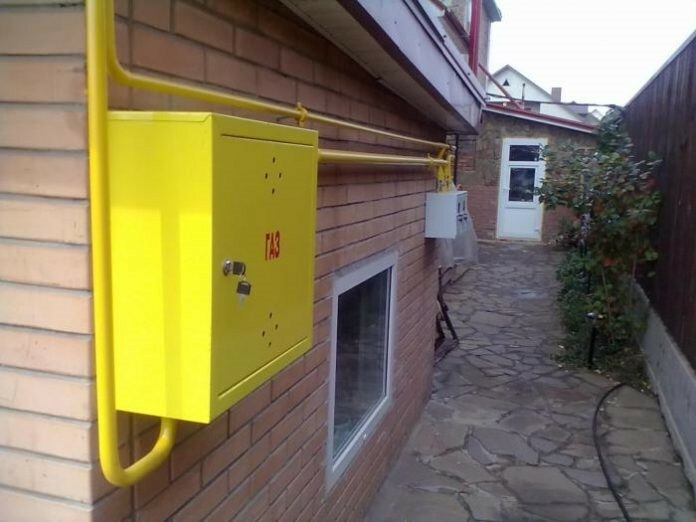
It is better to do everything at once in compliance with all standards than to risk your own safety and still redo it after a fine
However, we recommend waiting for it, and not contacting third-party specialists, who often do not have permission to perform such work.
In order to speed up the process, we recommend that you proceed in the following sequence:
- Collect a package of documents: confirmation of ownership of the site and the house; the current gasification plan, according to which the pipes have been laid at the moment; perhaps - a site plan with notes on all types of communications. Consider how you would like to position the new pipe.
- With the listed documents, contact Gorgaz or your regional gas supplier and make a written application with a corresponding request, indicating your address. Usually employees provide a standard form for such a case.
- Wait at the indicated address for a gas service worker who will assess the situation live and confirm the possibility of the proposed transfer or suggest his own version. The same employee or another specialist will make an estimate, calculating all the necessary materials and actions of gas workers. The cost of work and the complexity of the procedure will increase significantly if it is necessary to draw up a new technical plan for the placement of gas equipment - for example, when, due to a change in the point of gas introduction, it is planned to move a gas boiler, column, stove or other devices.
- Pay the receipt according to the estimate, after which the date of the work will be assigned.
- When the workers arrive, check with them that they have a permit to service the gas pipeline. It must be confirmed no more than 1 year ago. Then you just have to observe the work of professionals. If necessary, they will shut off the gas supply in the main pipe, cut off the old branch with a grinder and weld its place. Then a hole will be made in a new place in the pipe, a new branch will be welded to it, if necessary, a crane will be installed, the pipe will be fixed to the wall or on supports. At the entrance to the house, according to the work plan, the new pipe will either be welded to the trim of the old one, or it will be brought inside, up to the counter. Finally, the tightness of all welds and joints is checked. Do not let go of the masters until you re-read the act drawn up by them, which should list all the work performed on the gas pipeline.
- With the received act, once again contact the gas service to make perfect changes to the technical documentation of the house and site.
A new pipe must be treated with 2 layers of metal primer, and on top, apply 2 layers of moisture-resistant paint, always yellow. Painting in other colors and disguises are not allowed.
Option number 3 - open channel in siding
If you fool around with gas workers and move the pipe there is no time, no money, no desire, you can bypass it when sheathing by building a channel from siding. However, this solution also has disadvantages: the work is quite time consuming, the appearance of the facade can suffer, and due to the lack of insulation, a cold bridge will remain under the pipe, along which the wall can freeze through.
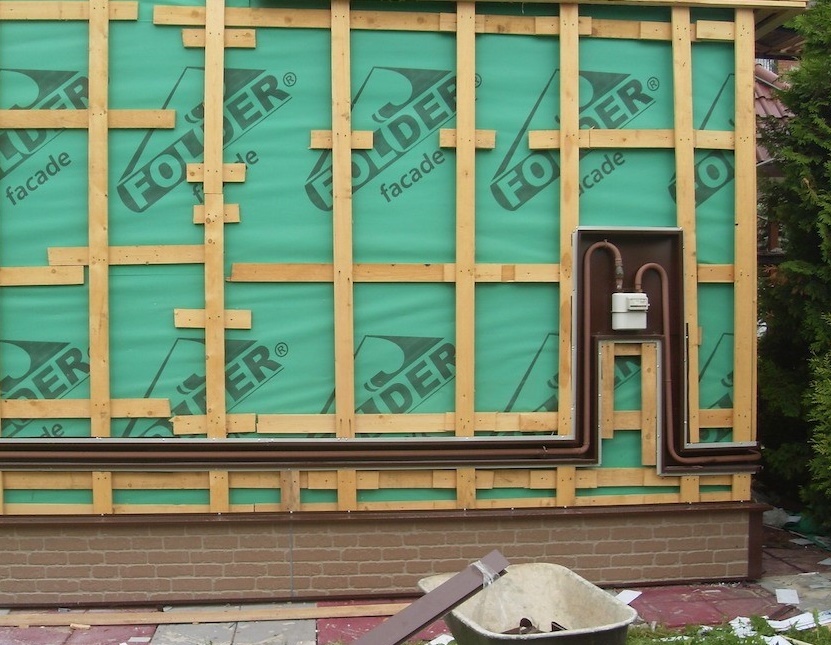
For added safety, the channel walls can be trimmed with metal. The lathing can be assembled from a wooden bar or a metal profile
It is advisable to use this option if the pipe was initially laid correctly - no closer than 5 cm from the wall, and the siding master is ready to take on such a task.
Among the additional costs will be corner and j-shaped siding profiles - their length is 2 times longer than that of pipes along the wall, additional profiles or beams for the lathing, as well as the services of a master performing work. The construction of such a canal is quite troublesome, so it will cost a little more than sheathing a flat wall.
Depending on the qualifications of the master and the length of the section where the channel will be, as well as on the type of siding itself, the work can take several hours to a couple of days.
If it’s time to paint the gas pipe, it’s better to do it before sheathing. It is necessary to provide for the arrangement of the channel at the very beginning of work, when arranging the lathing for siding or under insulationif there is one.
During this period, it is necessary to lay 2 horizontal beams or profiles along the pipe: one close to the wall, and the second flush with the main lattice for siding. The distance to the pipe is calculated as the thickness of the siding plus 6 cm, and it is advisable to add a couple more centimeters of headroom.
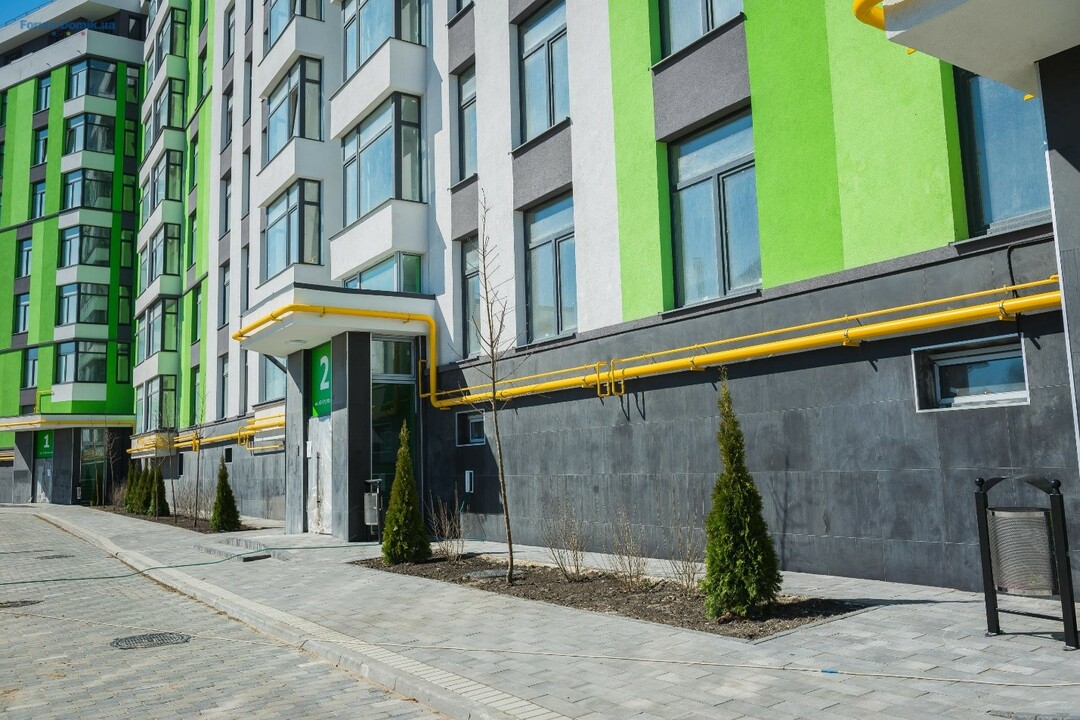
With proper design, the pipe can become a decoration, part of the facade design. Try to turn a disadvantage into an advantage
If the main siding is too embossed - for example, imitates the logs of a log house - for the channel it is better to purchase even plastic to match the color of the facade. When sewing on channel siding and installing corner profiles, care should be taken not to damage the pipe with the tool. At the end of the work, on all sides of the pipe, there must be a distance of at least 6 cm to the sheathing material.
The question of aesthetics is one of the key issues when looking for a solution with a gas pipe and house cladding, therefore so that such a structure looks more aesthetically pleasing and does not spoil the appearance of the facade, there are several recommendations:
- it is better to choose a siding of a color that will be combined with the yellow color of the pipe;
- make a gutter along the entire length of the wall, and if the pipe wraps around the house - along the entire perimeter of the building;
- you can organize the illumination of the channel, turning it into an artistic idea. If the house is one-story and the pipe runs along the top of the wall, the gutter under the cornice will look spectacular, which will additionally create darkening and emphasize the backlight;
- sometimes it is suggested to turn such a channel into a box, closing it from the outside with a removable strip of siding with ventilation. But gas workers themselves cannot answer unequivocally whether it is possible to close gas pipes with siding in this way - it seems that there is access for maintenance along the entire length, but at the same time it is closed. Therefore, even having received the approval of one employee of the gas service, you can run into a fine when checked by another employee.
How exactly disguise the gas pipe beautiful and safe - the choice is yours!
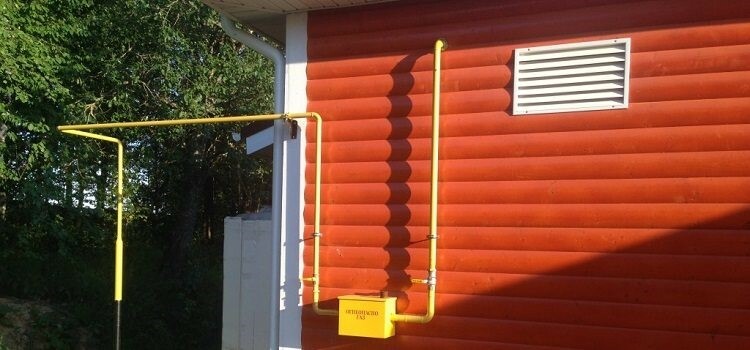
The pipe looks best when the siding color is combined with yellow. Choose from shades from white and beige to red, red, brown and even black
We remind you that it is forbidden to paint the pipe in any color other than yellow, as well as to mask it with any finishing materials.
Sewing up a pipe - what is the threat?
Some owners prefer to ignore all the rules and regulations and do what is most convenient: sew up the gas pipe with siding. We will describe the possibilities and threats of this option below.
As a rule, this is done by those homeowners whose gas is brought into the house from the back, invisible from the street side, and controllers from the gas service come extremely rarely. However, do not forget about the danger of such a decision, because the rules were written not in order to write out fines, but to ensure the safety of your life and health.
Initially, no additional investment is required - the pipe will simply be under the casing. However, if the controllers see this, you will be cut off from the gas supply until the situation is corrected, and you will have to pay not only the equipment of the gutter in the lining or the transfer of the pipe, but also the fine, and the repeated connection.
Sewing a pipe tightly will take the same amount of time as it generally takes to clad a given wall with siding. If later you have to redo everything according to the standards, then time will be added to the installation time to disassemble the cladding of the upper half of the wall.
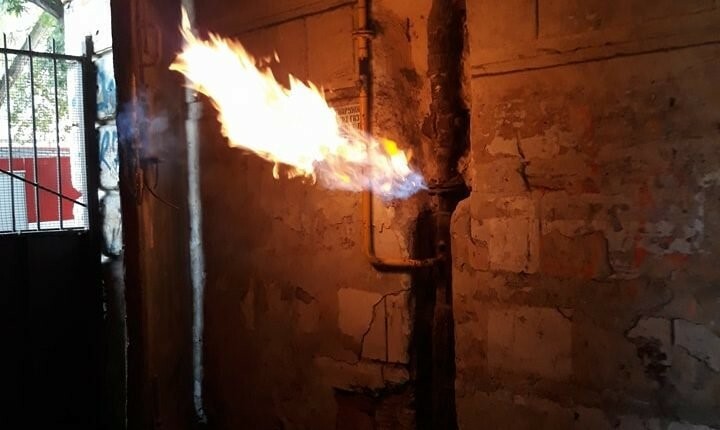
Leaking gas can cause fire or explosion. Imagine if such a torch appears under the siding, and even near the insulation
If such a situation arises at the direction of the controller, your house will be cut off from the gas supply for the entire period of the refurbishment. If the pipe is moved, it can be a month or more.
If you nevertheless decide on this option, take care, if not about observing the rules, then at least about your own safety. To do this, do not lay the pipe tightly with insulation, leave at least a small cavity along its entire length.
In the siding at the pipe level, make several ventilation holes, and in one of the gaps between them, install gas analyzer - a sensor that can warn you in advance about a leak.
Conclusions and useful video on the topic
This is how a pipe looks like, sufficiently moved away from the wall on the fasteners-clamps:
How to build a channel for gas pipes will be discussed in the following video:
The decision whether to hide the gas pipe under the siding remains only with you, but the responsibility for such a decision, its consequences, is yours. Once again, weigh the pros and cons of each option specifically for your situation in order to choose the best path.
Have you already encountered such a problem? If so, how did you solve it? Perhaps you know other options for a way out of a similar situation? Share your experience in the comments below - we are interested in your opinion.


